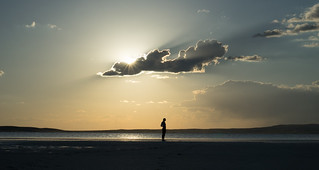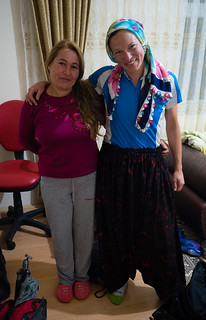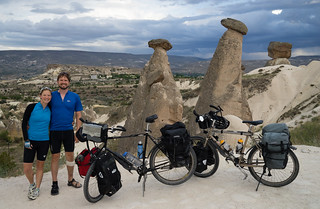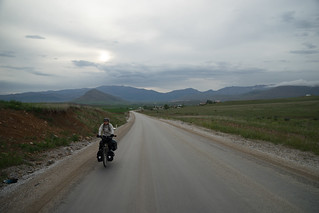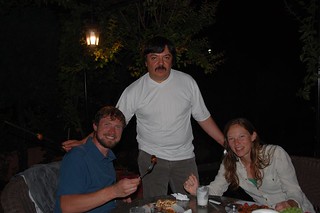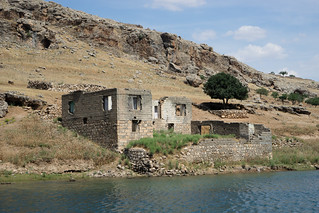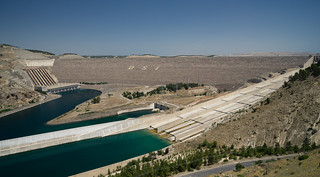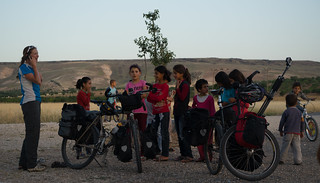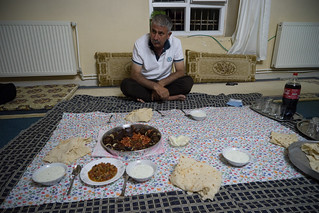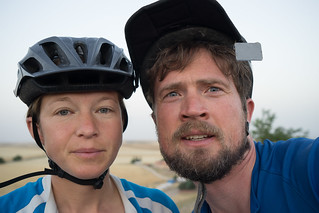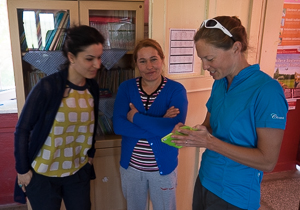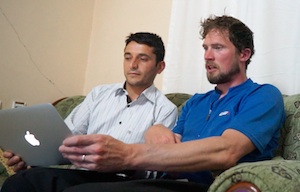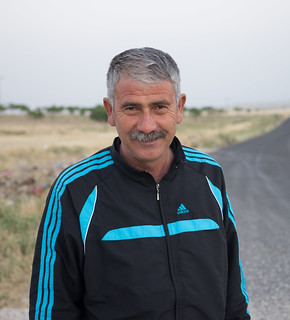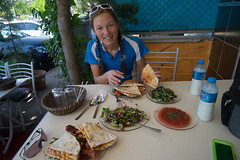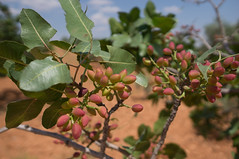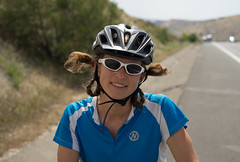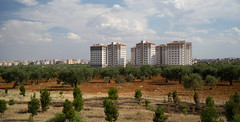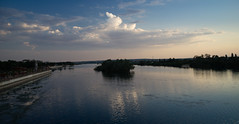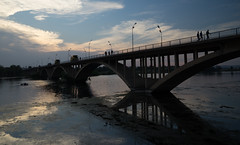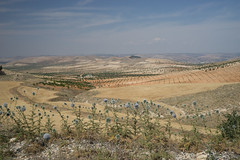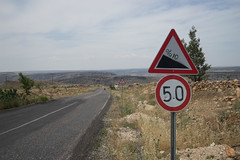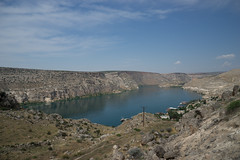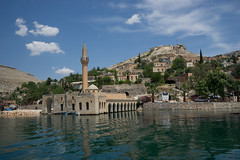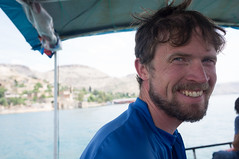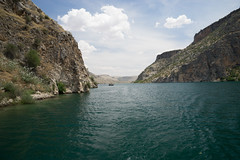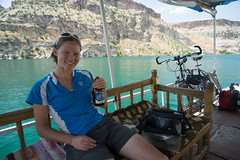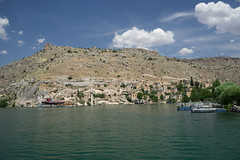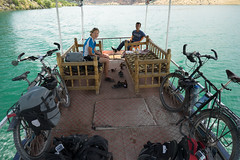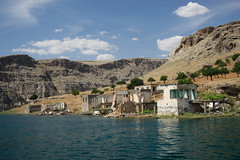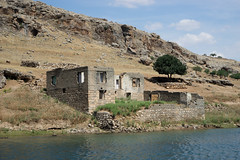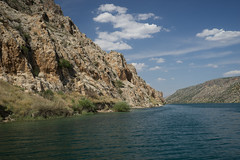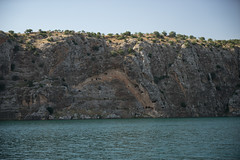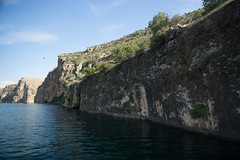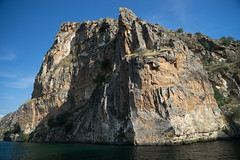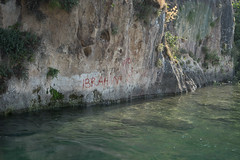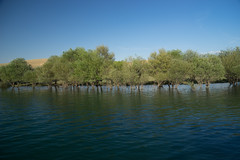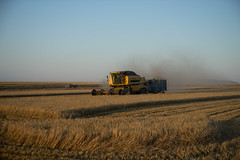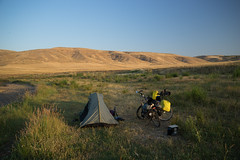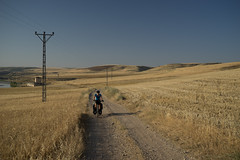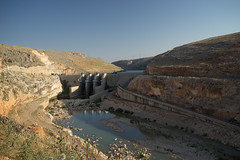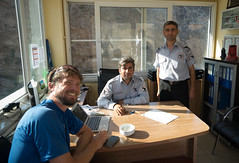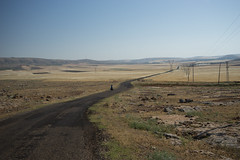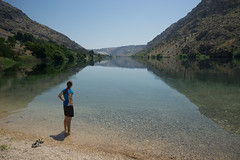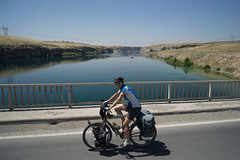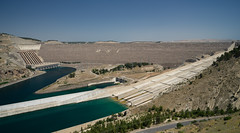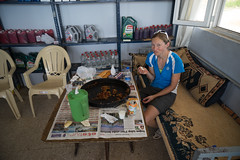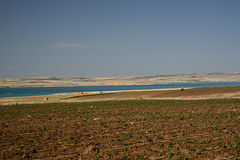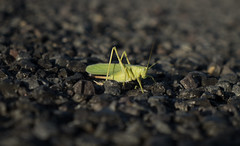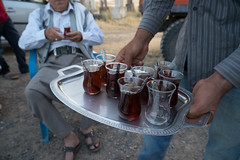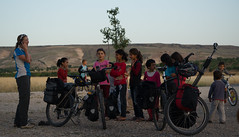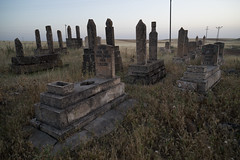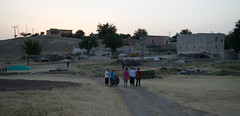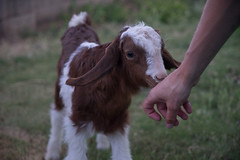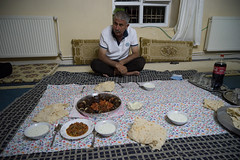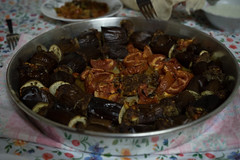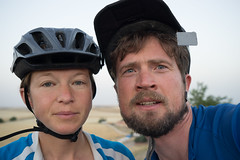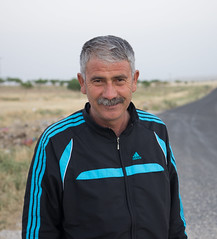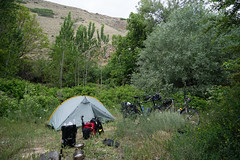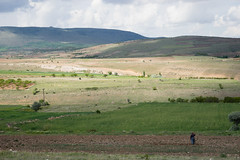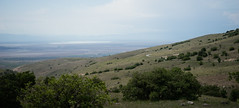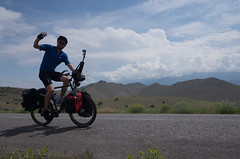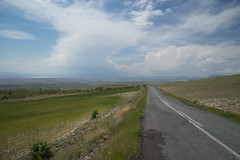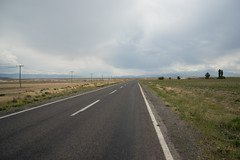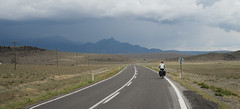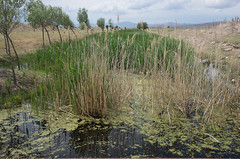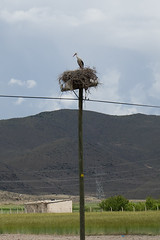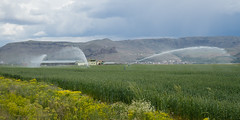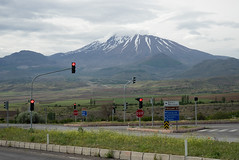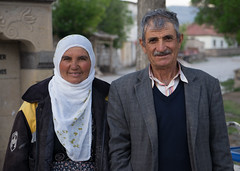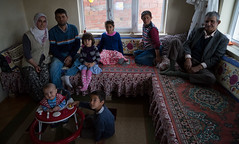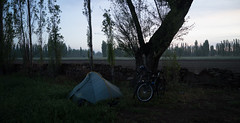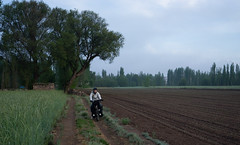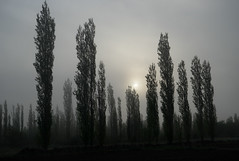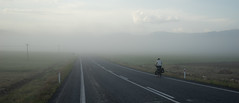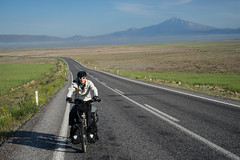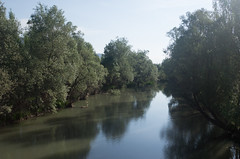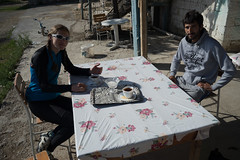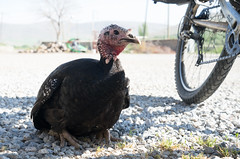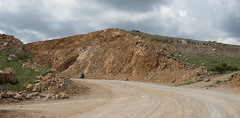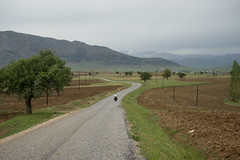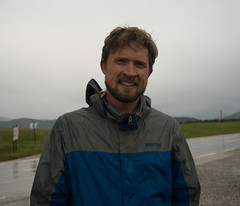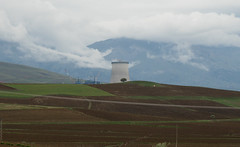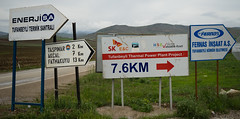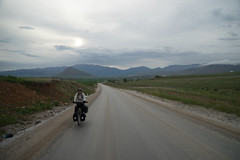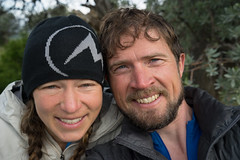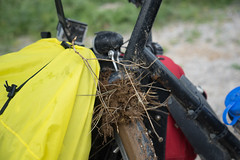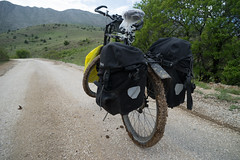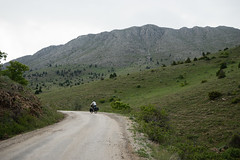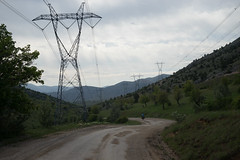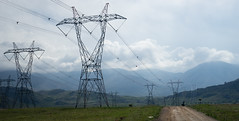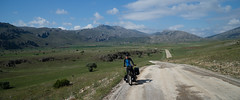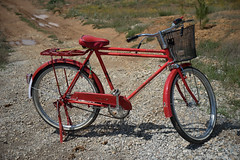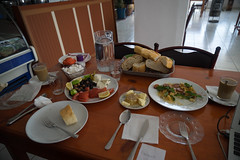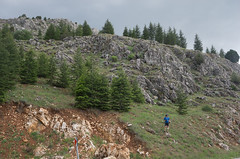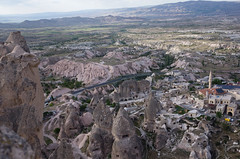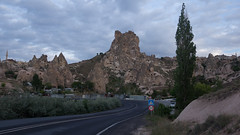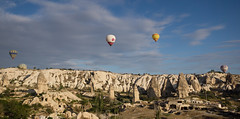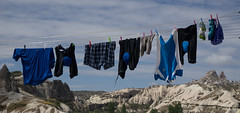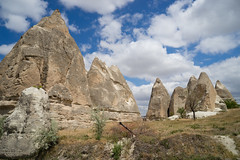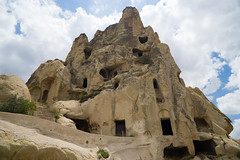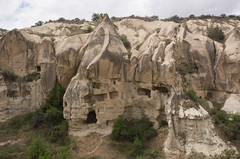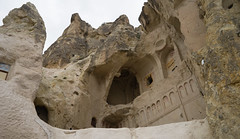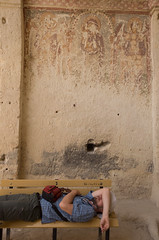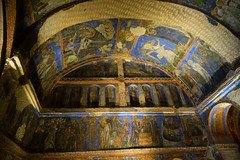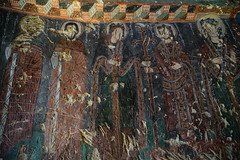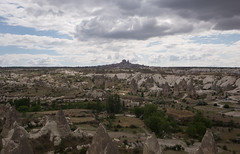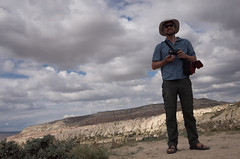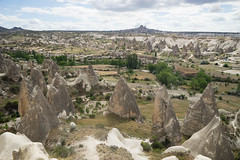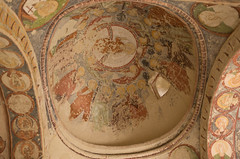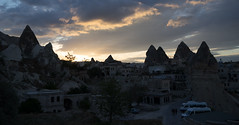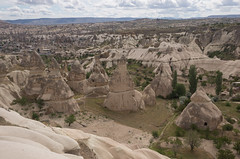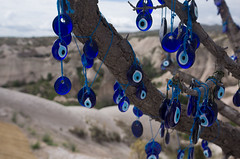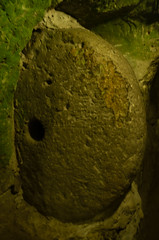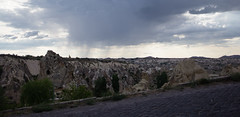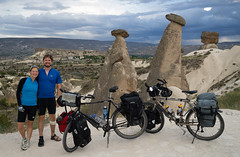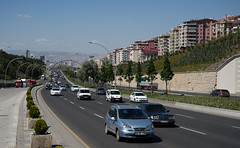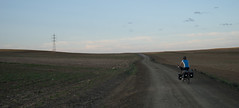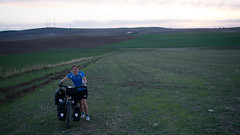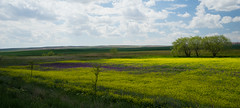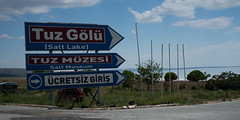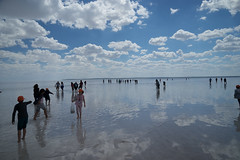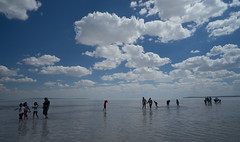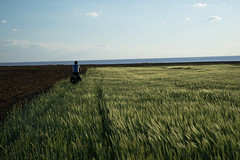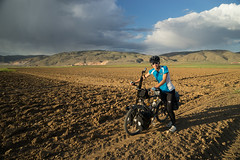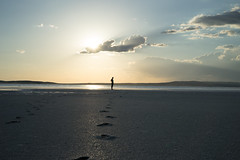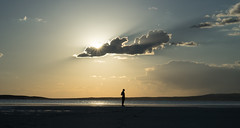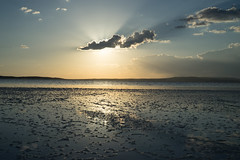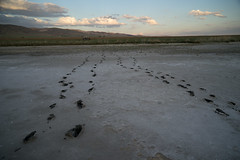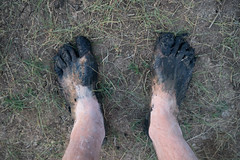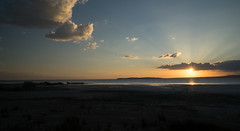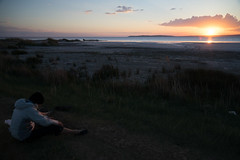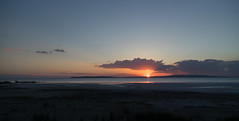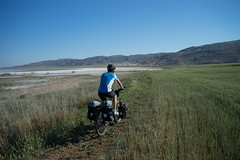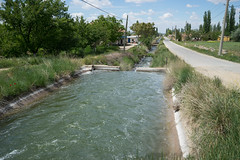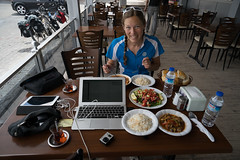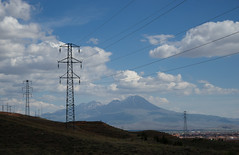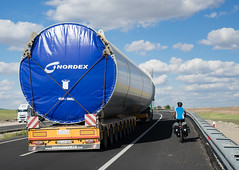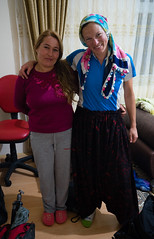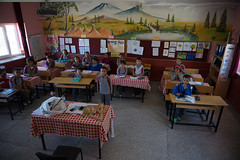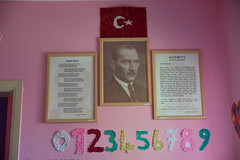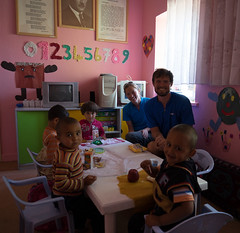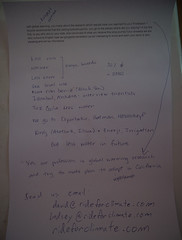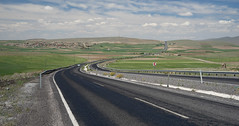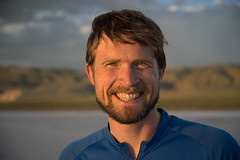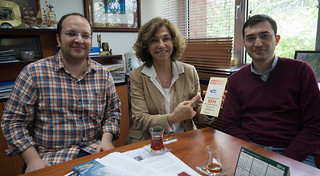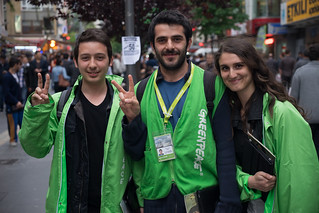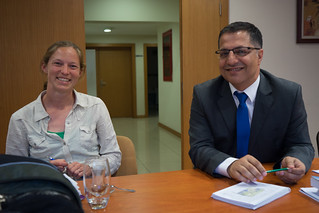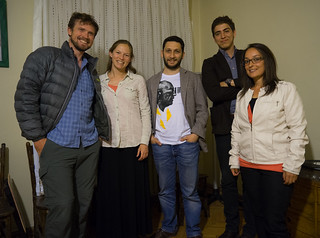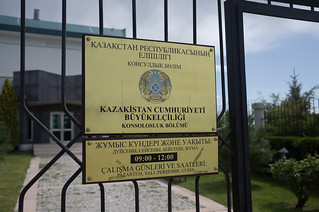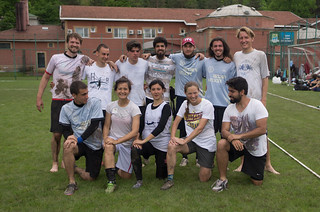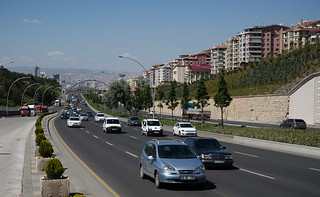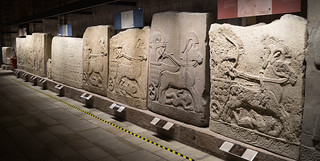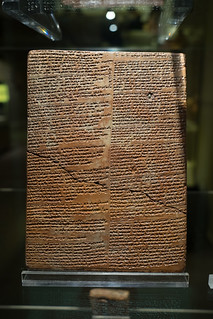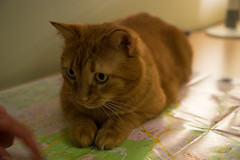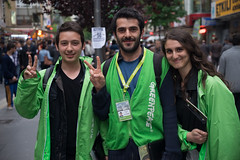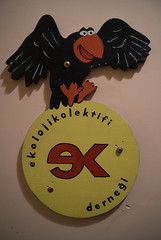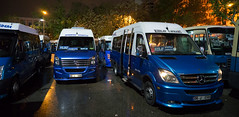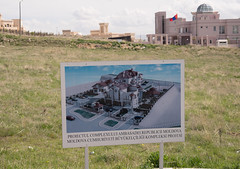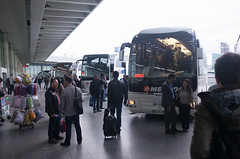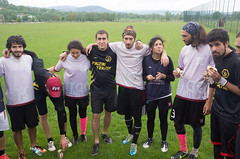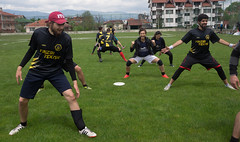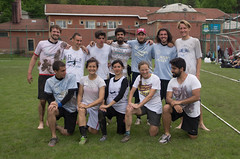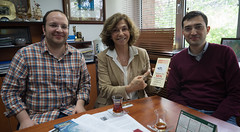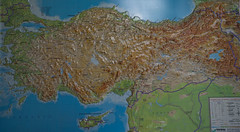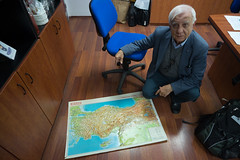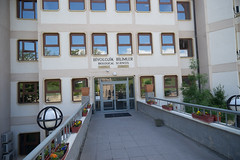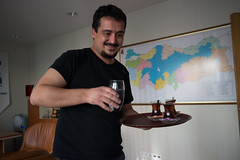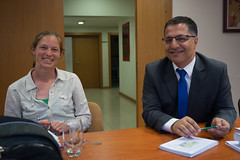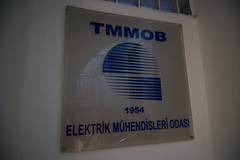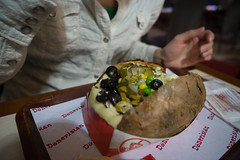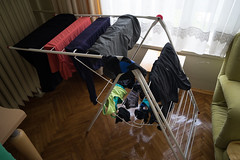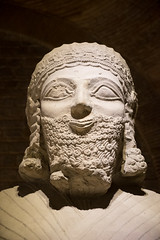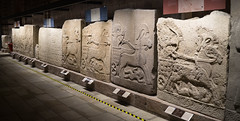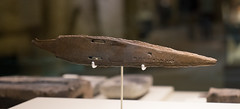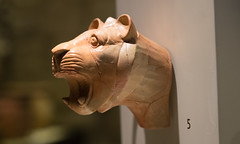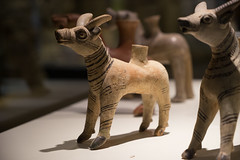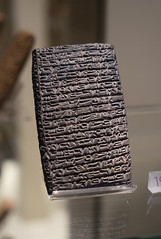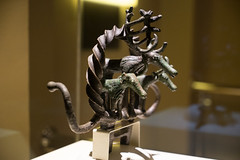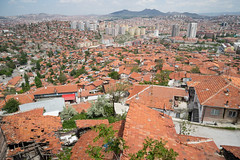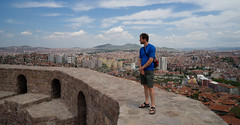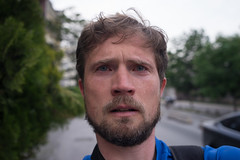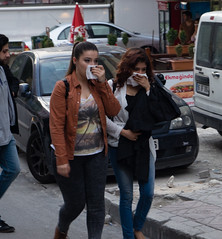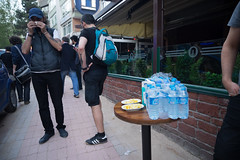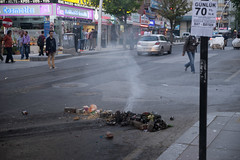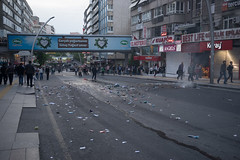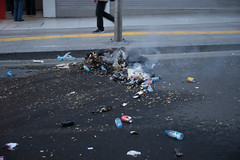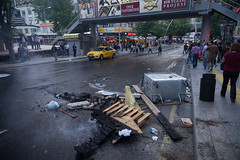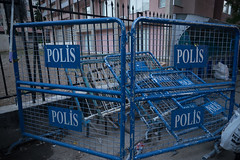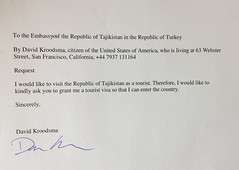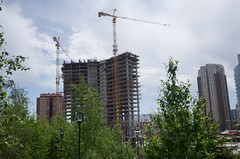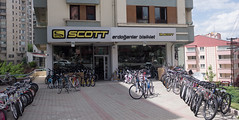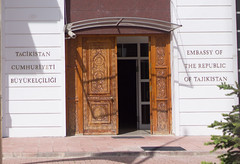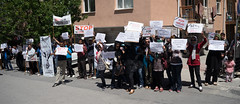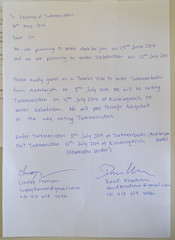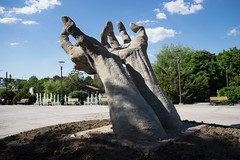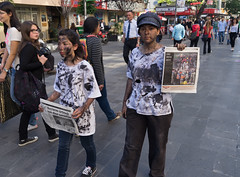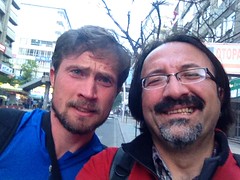After 10 days in Ankara, we set out in the afternoon towards Cappadocia. We decided to take a less direct route so we could see Tüz Gölü, a large salt lake. It took quite awhile to get out of Ankara, following a busy highway uphill through the outskirts of the sprawling city. We made it to a more rural area and camped off the road in a field. The next day the lake came into view, and we followed its shoreline for most of the afternoon. The lake – the 2nd largest in Turkey – is what remains of a huge lake from the last ice age; around its shore for as far as we could see, people were growing wheat in the perfectly flat former lakebed. This landscape made for very fast biking, and we enjoyed traveling a great distance without too much effort. That night, we made it our goal to camp along the shoreline – this turned out to be a bit challenging, as we had to push our bikes through fields for quite a ways, but it was totally worth it – we set up our tent and made dinner as the sun set over the lake, and we waded out into the salty flats and enjoyed a bit of wine – our first sip since Istanbul.
The following day we left the lake, biked across the old lakebed, then climbed up towards Cappadocia. We made our first friends on the road that night when a shepherd saw us setting up camp outside of his village and, along with his wife, insisted that we stay at their house. It was wonderful to finally meet people on our route and get a bit more perspective on where we were biking through. They helped us dismantle our tent and pack everything up, led us to their house in the dark, and fed us a 2nd dinner despite our insistence that we had already eaten. Sakine and her husband Çemali were very adept at communicating with foreigners – through gestures, a dictionary on our phone, and our rudimentary Turkish, we discussed their families, jobs (Sakine helps out at the local school, and Çemali is a shepherd for Sakine’s parents’ sheep). We learned that they are our age, their sons are 12 and 8, and that they make their own yogurt, cheese, and butter, and sell the wool from their sheep. The next morning, we visited the school and even talked about climate change. Sakine said that it was warmer and drier than it used to be, and that this year in particular it was hard to grow crops because of the lack of rain. Despite the language barrier, I felt a real warmth and friendship with Sakine and it was kind of hard to say goodbye. But, Cappadocia was calling.
We arrived in Uçhisar in the late afternoon and got our first glimpse of the gnarly Cappadocian landscape. We had been planning to stay with a warmshowers host, but communication had been difficult – we weren’t sure if he was actually home or where his house was – and when we descended into Goreme, we decided to get a hotel, relax, and be tourists for a day or so. It’s a bizarre place, and also the most touristy experience since Istanbul. We visited the open air museum of old cathedrals carved into the rock, wandered through the valley full of fairy chimneys – crazy pillars of rock sculpted by water and wind, with small houses carved into them – visited an underground city, did some housekeeping, and left late on our 2nd day. We camped by a nice stream tucked behind some fields after we left town, then continued on our way.
We’d decided to take the less obvious route to Gaziantep, on small roads through the mountains. Two different people told us it was impossible because it’s so steep, so naturally we were pretty pumped about our decision. We camped in the rain and left before sunrise the next morning – biking through farmland in the early morning mist left by the rain was beautiful, if a bit eerie. This turned into the day of tea. We stopped for breakfast near a house – and were invited for tea. We climbed 2,000 feet over 10 miles (this was the ‘impossible’ part, we figured), and at the highest pass of the day shared some tea with a road construction crew. We managed to duck into a gas station before the skies broke open that afternoon, and accepted several glasses of tea from the men working there. When the rain stopped, we wound our way through several small villages, dodging muddy cows coming in from the pasture. After passing through a small town with no market (we did our shopping at a gas station market where everything was well past its sell-by date), we saw a new power plant in the distance, and several busloads of workers coming home from the plant passed us as we pedaled by.
We spent another night camped in a pasture, then got another early start; we had about 200km left until Gaziantep and we hoped to make it in 2 days. However, it was another long day of climbing with more rain, and shortly before sunset we realized we weren’t going to make it as far as we wanted. We got groceries in a small village, then asked around for places to camp. The first few people we asked told us we’d find something in 10 or 20 km, but when we rolled up to a house, before we could even say ‘çadir, camping, nerede?’ (tent, camping, where?), they beckoned us inside making eating motions – it almost felt like they were scolding us for being late to dinner. We asked about camping and they motioned to their yard, so we happily accepted their hospitality. After a long day of riding, facing the task of searching for a campsite and making pasta over a camp stove, it was magical to walk inside and find a tablecloth on the floor covered with dishes of eggplant, tomato, and goat stew, yogurt and cucumber salad, and lavash (flatbread). It wasn’t until we had stuffed ourselves that we realized I was the only woman in the room. Our hosts were a family with the grandparents, their son, his wife, and their children; the grandfather and father were joined by several of their (male) friends, and the grandmother and mother drifted in and out to clear dishes and bring tea, but they didn’t sit with us. I spoke with them a bit, but they mostly stayed in the kitchen. It felt a bit odd, and their modest attire (long skirts, long sleeves, scarves covering their heads and necks) made me glad I was wearing my bike leggings and not just shorts. We had a lively conversation with the father and grandfather, asking them about climate change using Google Translate. Like Sakine and Çemali, they too had noticed that it rained less and was hotter. Another interesting moment was when they pointed to the light and said “Atatürk,” indicating that the electricity came from Atatürk Dam. The next morning, the women made another delicious meal (which we ate with the grandfather), and then we were on our way around 5:00, with a goal of making it the last 120km to Gaziantep.
We made it, but we weren’t in the best shape – we had a long rest at a gas station during a torrential rainstorm, but no sooner had we left than the sky split open again. We ended up riding through a nearly-flooded road, then through pounding rain, and then suddenly it stopped and the road was bone-dry. I was falling apart – I don’t think I’d eaten enough – and we had to stop and eat what was left of our food along the freeway. Fortunately it had a wide shoulder and very little traffic – it was actually excellent for riding – and after a snack we pounded out the rest of the distance. Our warmshowers hosts surprised us about 5km from their house, took our panniers in their car, and, when we arrived at their suburban enclave – the only suburbs we’ve seen in Turkey – hustled us to the shower and then to their outside dining area where we ate massive amounts of kebab, bread, and salad.
They were such a nice family and fed us extremely well. We went into town the next day and visited the Zeugma museum, which houses mosaics from a town flooded by the Birecik Dam in 2000. The museum was very well-done and the mosaics were stunning. When we left Gaziantep, we biked to the town of Birecik, which sits on both sides of the Euphrates River downstream of the Birecik and Atatürk Dams. We were strangely excited to cross the Euphrates, and we spent some time biking along the shore. The next day we rode to Old Halfeti, or what is left of it after the reservoir flooded it. We also biked through New Halfeti, a comparatively bland town where residents were relocated. We were gripped by the sudden desire to take a boat as far up the river as we could (rather than bike out of the river canyon in the mid-day heat). Several people told us it was impossible, and that there were no roads upstream that came close enough to the river, but we eventually found somebody who knew the area well, and he agreed to take us up the reservoir as far as he could.
It turned out to be a wonderful afternoon. The water was clear (since all the sediment is trapped behind the dams), and we went up through the canyon, which had steep walls on either side, some of which had ancient cave houses carved into them. Immediately around Halfeti there was other traffic on the reservoir – tourists come to visit the partially submerged Rumkale (castle) – but once we passed that, and the adjacent flooded mosque, we saw virtually nobody for several hours. After awhile, our captain – who spoke no English – pointed to a flooded village on the east bank of the river. “Evim” he said – “My house.” His family had lived in the village until it was flooded by the dam, along with about 10-15 other villages, displacing about 10,000 people. He brought us to a couple of swimming holes – including one with steps carved into the rock that he said were 3,000-4,000 years old – and we tried to imagine what it would be like to have your whole town flooded, to go from being a fisherman on the Euphrates River, to taking tourists around the reservoir that swallowed your home.
We camped on a tributary to the river that night after being dropped off at the foot of a steep gravel road and biking through fields buzzing with combines harvesting wheat. The next morning, we had tea with the operators of a small dam on the tributary – it was built just 4 years ago, and they said that this year energy production was 25% of normal due to the drought. Later that morning, after more miles on dirt roads than we would have liked, we made it to Atatürk Dam. As promised, it is massive. Its capacity is over 10 gigawatts, which is one sixth of Turkey’s total installed electrical capacity. The turquoise reservoir stretches out for miles behind it, and we visited the friendly town of Bozova along its shore. We realized that we were squarely in Kurdistan – or the Kurdish part of Turkey – when people started correcting our rudimentary Turkish, replacing it with Kurdish words. Something had changed, though we can’t quite put our finger on it. People seemed happier, more gregarious, and they huddled around us, curious and smiling. When we asked for directions, people hopped in their cars and had us follow them, and we were invited to yet more tea on our reluctant way out of town.
It was extremely hot that day, and awhile before sunset we needed to stop in a village to ask for water. We still wanted to go farther, but when they invited us for tea… and then dinner… and then to spend the night, we gladly accepted. We spent that night with a lovely family that grows wheat and had goats, sheep, and ducks in the yard. They called a relative in town who spoke English (a common practice, we’re seeing), who confirmed that we were invited to stay, that the family was interested in us, and that we were very welcome there. Dinner was, as usual, delicious, and we had more fun with Google Translate and also learned some more Kurdish. Just like everybody else, they said it was warmer and drier. Interestingly, despite just being 2 km from the Atatürk Reservoir, they don’t get water from it and their crops are rain fed. We couldn’t communicate well enough to figure out why. We had asked about camping, but they insisted we stay inside on two mattresses set up on beautiful carpets in a room that was otherwise empty except for a TV and Quran. We wanted to get an early start since we still had 140km to Diyarbakir, so we got up with the father at 4:30 when he woke up to pray. It was a ridiculous day, with a long, deceptive climb that looked flat but was decidedly not, and a crazy wind storm whipping up from the desert in Syria. We were exhausted when we arrived, 15 hours later, but we had made it to our goal of Diyarbakir, an ancient city on the banks of the Tigris River.







